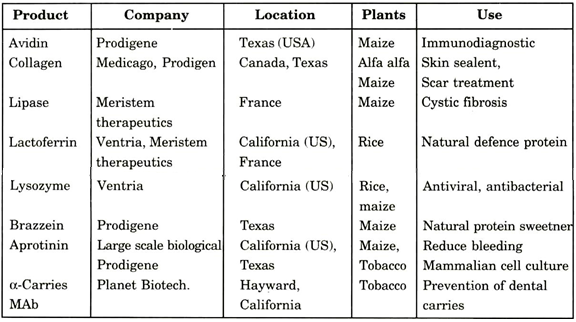ADVERTISEMENTS:
In this article we will discuss about the production of pharmaceutical proteins in transgenic plants.
Many pharmaceutical proteins of mammalian origin have been synthesized in plants. These ranges from blood products such as human serum albumin. There is an annual demand of more than 500 tonnes for many of these proteins. In view of their economic feasibility, transgenic plants have been exploited for production of proteins (Table 16.2 and 16.3).
Table 16.3 Plant molecular farming products proposed to hit market closely or in the next 5 years
1. Glucocerebrosidase:
This is an enzyme break up glucocerebrosidase into glucose and ceremide as aged red blood cells are removed by body. Gauchier’s disease is an inherited disease due to deficiency of glucocerebrosidase resulted in accumulation of glucocerebroside in lysozomes and leads to swellings of liver and spleen.
This disease can be managed by drug developed from enzyme purified from the human placenta. However, cost effectiveness of the drug makes glucocerebrosidase (hGc) is one of the world’s most expensive drugs. The treatment with this drug cost $300,000 per year and one of the main reasons for cost of this drug is that the enzyme is derived from human placenta.
ADVERTISEMENTS:
ADVERTISEMENTS:
It takes 2,000 to 9,000 placentas to produce a single dose of this drug or 8-10 tonnes of placenta are required to treat one patient for a year. Production of this drug in using mammalian cell culture has subsequently reduced but still cost of the drug is unaffordable. Fortunately Carole Cramer and her associates at Crop Tech Development Corporation at Virginia (USA) have developed transgenic tobacco plants that produce this drug and it was patented.
Their studies with plants as production system opened a great potential for the production of glucocerebrosidase and other lysosomal enzymes for enzyme replacement therapy and bring down the cost of this drug by a thousand fold. This plant transgenic technology can remove this drug from the most expensive label.
2. Therapeutic Hirudin Protein:
This is an anticoagulant peptide of 7 KD produced in salivary glands of leach Hirudo medicinalis. It is a potent inhibitor of thrombin. Thus, it has a high therapeutic value in the treatment of thrombosis. Killer disease like heart-attack and strokes are caused by clotting of blood. Presently, anticoagulant like hirudin as therapeutic agent has several advantages over heparin.
The immunogenecity of the protein comparatively low and does not have any interaction with any protein in the blood. Earlier attempts on the production of this protein in E. coli and yeast were found to be a reasonable success. Extended work suggested the production of this protein in plant system particularly oil producing crop.
One of the obvious reasons for selecting oil plants is due to its simple and novel purification make pharmaceutical proteins are economically accepted. A synthetic gene for hirudin protein with well plant codon usage was expressed in Brassica napus. The hirudin gene was fused to Arabidopsis oleosin gene and endoprotease factor Xa cleavage site was inserted between C-terminus end of the oleosin and N-terminus end of the hirudin.
Oleosin protein always associated with the surface of the oil bodies. Presence of oleosin gene along with hirudin could be targeted to the oil bodies. Targetting oil bodies could facilitate easy purification. Transgenic Brassica rapa expressed this protein with its C-terminus fused to oleosin oil body associated protein. After production, these are then separated by using protease cleavage site.
The seeds are crushed in buffer, centrifuged to allow oleosin and pharmaceutical protein on the topmost layer. The oil bodies can be separated easily, recentrifused and treated with protease to separate hirudin and oleosin. Recentrifuge can be done to procure highly purified hirudin protein in aqueous phase.
ADVERTISEMENTS:
This production system appears to open up a new simple purification system based oil body oleosin technology make pharmaceutical protein produced in transgenic plants are economically significant. In addition, this method of purification ensures that hirudin in the plants becomes active only after harvesting and limited exposure to environment.
3. Human Serum Albumin:
Diseases like cirrosis and skin burns can be treated with human serum albumin (HSA). To meet its greater demand in medical applications, potato and tobacco plants have been used to produce HSA. Expression of HSA was achieved using 35S promoter and different signal to ensure secretions.
One of the forms of HSA has human prepron sequence, while the other had tobacco extracellular PRS protein signal sequence. However, correct processing of HSA when compared to human preprosequence of plant signal PRS was greatly appreciated in their analysis. The human serum albumin accumulated to 0.02% of total soluble protein. However, restricting expression to seeds can be resulted in higher yield.
ADVERTISEMENTS:
4. Trichosanthin:
Similarly, another therapeutic protein produced in transgenic plant is trichosanthin. The ribosome inhibiting protein, trichosanthin accumulates upto 2% in Nicotiana by employing RNA virus as vector.


